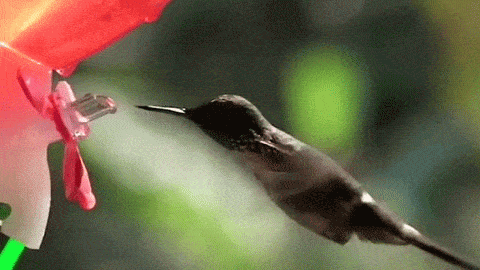The beauty of hummingbirds is unmatched.
Do you agree?
From iridescent violet throats to metallic green upperparts, these stunning birds are worth a full birding tour of the state.
We'll tell you where to go and how to attract these birds to your backyard if you want to enjoy birding at home.
We'll only talk about common hummingbirds in California, not rare species like the broad-billed hummingbird.
California Hummingbirds Common Throughout The State
How many hummingbird species have you seen so far? See if you know the ones below:
1. Rufous Hummingbird
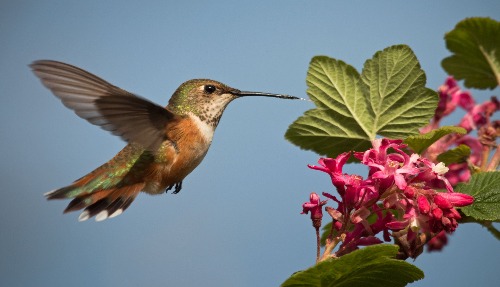
Rufous hummingbirds are aggressive, always chasing away other hummers in your backyard.
They even attack birds larger than this hummer's 2.8 to 3.5 body length.
If you don't know how to ID them, here are some physical characteristics. They have an almost straight bill and short wings. A male rufous hummingbird has an orange back and belly, and the throat is iridescent red.
Females and immature male birds have green upper parts, rusty flanks, a green tail with rusty spots, and an orange patch on the throat.
This hummer is a long-distance migrant that flies almost 4,000 miles from the breeding grounds in Alaska and Canada to the wintering grounds in Mexico. In spring, it flies north to the Pacific Coast and back to the Rocky Mountains in late summer. It also breeds in some southern states like Florida, Georgia, and South Carolina.
Fun Fact: Aside from the places mentioned above, the Rufous Hummingbird is likewise one of the hummingbirds in Ohio, although quite rare to catch a glimpse of!
2. Costa's Hummingbird
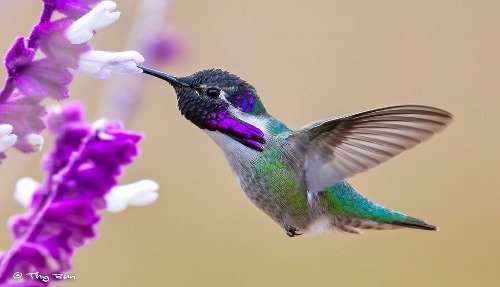
It's one of the southern California hummingbirds because there's a resident population in that area. This short-distance migrant has a breeding range on the edge of California and in neighboring states like Nevada and Arizona.
An iridescent purple throat is the first characteristic you'll notice on a male Costas hummingbird. This gorget goes over the head and flares out on the sides.
A female hummingbird isn't as colorful, but it boasts a white throat, a white underbelly, green feathers on the head and back, and white tips on the tail.
A Costas hummingbird likes desert scrub and woodlands. It visits over 1800 flowers to get a day's energy. Therefore, a hummingbird feeder with sugar water is always a solution.
During the breeding season, the male defends the territory using a high-pitched whistle that it sings to keep off intruders from the three or four perches in its territory.
Lastly, a female builds a nest up to seven feet off the ground using leaves, lichen, and bark strips. The nestlings live there for up to 19 days.
Pro Tip: You could increase the chances of male and female Costas hummingbirds mating and nesting by providing them with a good quality bird house for their hatchlings!
3. Calliope Hummingbird
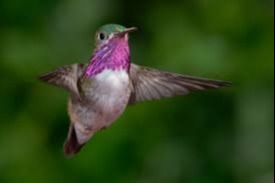
It's the smallest of the ones you'll see in North America as it's between 3.1 and 3.5 inches long. However, it's not the smallest globally as a bee hummingbird is about 2.4 inches long.
A male bird has a magenta throat with some feathers falling down the neck like streaks. Its upper parts and sides have metallic green plumage, while its breast is white.
A female calliope has peachy underparts and a bronze-green back. Its throat isn't as colorful as a male's. A calliope's plumage is similar to the colors of a rufous hummingbird, but you can tell the two apart by their bill and body size. A calliope hummingbird is smaller, while a rufous avian has a longer bill.
California is in the breeding range of this long-distance migrant. It flies north in spring and moves south to Central America in the fall, 5,000 miles to and from the breeding range.
Even though most sightings are in western states, calliopes are also in eastern states like North Carolina and Florida. If you're exploring its wild habitats, look for a hummingbird perched on a bare branch of willow or alder shrubs.
This avian's breeding grounds are up to 11,000 feet high unless it's breeding along the Columbia River, under 1,000 feet off the ground.
A female builds a cup-shaped nest on an evergreen tree like a western red cedar or a lodgepole pine. It finds a spot with an overhanging branch to shelter the nest from the rain. You might even miss its nest as it builds where an old pine fell out, making the nest resemble a cone.
It can construct a nest anywhere from six to 39 feet off the ground after gathering bark and moss for the nest's exterior.
Nectar, insects, and sap make up its diet. You'll see it looking for sap and insects on sap wells of other species. In addition to nectar, you can also plant flowers to make your yard more comfortable for this species.
Pro Tip: Make it easy for your gliding friend to find nectar, insects, or sap by knowing where to hang hummingbird feeders in your backyard.
4. Anna's Hummingbird
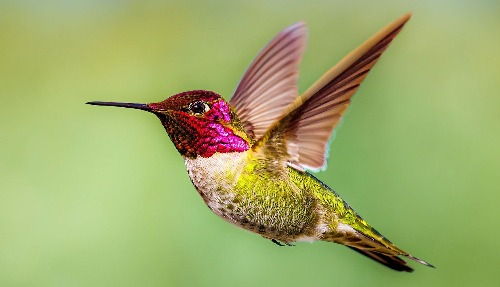
It's one of the common types of hummingbirds in California, recorded by many birders throughout the state, including places like Santa Barbara.
Its habitats include deserts, woodlands, and parks. On top of that, Anna's hummingbird will come to your backyard if you have a nectar feeder. It also loves insects so much that it can pluck insects caught in a spider's web.
This tiny bird is about 3.9 inches long from bill to tail. You'll know it by its iridescent reddish-pink head and throat, though a female has a grayish throat with red spots here and there.
You're likely to see this species along the Pacific Coast because it rarely migrates. There's a resident population in this and neighboring states. But, the hummingbirds in Northern California may fly a short distance to places with more food.
You'll enjoy watching it courting as the male flies about 130 feet high and dives meticulously.
It builds a nest from six to 20 feet off the ground using willow, thistle, and feathers stitched together with spider webs.
Lastly, Anna’s and the magnificent hummingbird got their names from the same historian.
5. Black-chinned Hummingbird
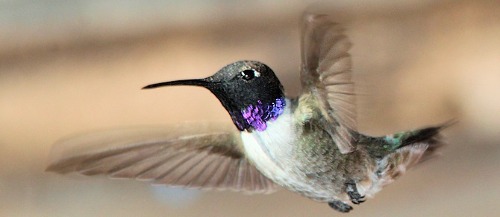
It's a medium to long-distance migrant that flies from the breeding grounds to higher grounds with more flowers. The wintering grounds are in the Gulf Coast and western Mexico.
California is the bird's migration range, with the coastal strip offering breeding grounds.
It loves mountain and alpine meadows, urban settlements, orchards, and canyons with dense thickets.
You'll see it capturing small insects in flight or on the ground.
The most striking physical characteristic of the black-chinned hummingbird is its iridescent violet throat. It adds so much color to the metallic green upper parts and white breast. The female has a greenish-gray cap and a gray throat with dark spots.
A male black-chinned hummer can dive between 66 and 100 feet in a courtship ritual or when defending its territory.
This hummer is about the size of a ruby-throated hummingbird, and it nests on dead branches under a canopy, from six to 12 feet off the ground. The nest starts as a deep cup and stretches as the nestlings grow.
6. Broad-tailed Hummingbird
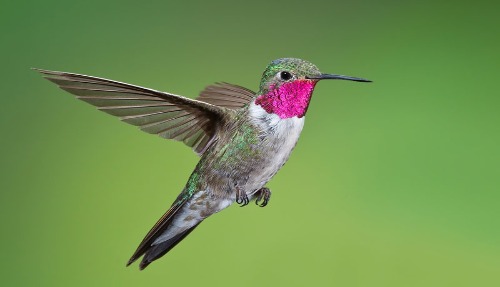
It finds mountain meadows and open woods more habitable, so its breeding grounds are over 5,000 feet above the ground. The body temperature drops, and the heart slows down until the sun shines for this bird to cope with extreme weather conditions at high elevations. This medium-distance migrant stays in this state for a short while.
A broad-tailed hummingbird forages in pine-oak forests or thorn forests in winter. It prefers nectar from red columbine, scarlet gilia, and Indian paintbrush. However, it can feed on less common flowers like glacier lily and pussy willow when migrating.
A male bird has a rose-magenta throat, green and buffy sides, a white breast. The belly of a female bird is brownish, while its breast is white.
A female builds a nest alone, designing a cup-shaped home that can house two eggs for the incubation and nestling periods. It searches for a sheltered spot on an evergreen branch with a canopy or thicket, up to five feet off the ground.
If you see one gathering material for the nest, it'll be searching for spiderwebs and gossamer for the interior and lichen or moss for the exterior. The process takes up to five days though it can take a shorter time if the new nest sits on an older one.
Pro Tip: You could provide them with a high-quality bird house if you have the time and budget to craft one!
7. Allen's Hummingbird
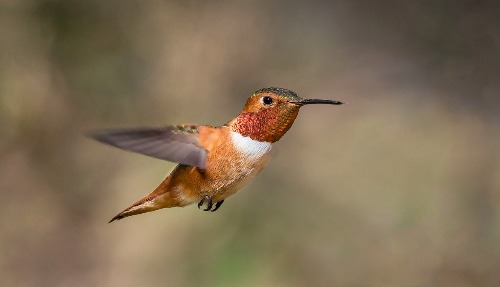
Allen's hummingbirds breed in a strip of the coastal shrub. One of the subspecies in the breeding range in southern California migrates a medium distance to winter in central Mexico. There's a resident population of the other subspecies in the Channel Islands and areas of Los Angeles like San Pedro.
Birders in Arizona and New Mexico can also see these migrating hummingbirds, plus the blue-throated hummingbird.
You'll know you're looking at Allen's hummingbird if it has an orange belly, metallic green feathers on the back, and a stunning reddish-orange throat. It measures 3.5 inches long. The female avian has the same back plumage but duller, with pale coppery sides.
The two sexes live in different places during the breeding season.
The male prefers open lands overlooking the coastal shrub, and the female migrates after mating in such open lands to build a nest in a thicket or forest.
How To Attract California Hummingbirds To Your Feeder
Install Nectar Feeders
You can offer many foods to backyard birds, from sunflower seeds to millet. If you're attracting hummingbirds, you need a nectar feeder.
Make Nectar
These tiny, lovable bids need energy for their active bodies, and giving them sugar water will do the magic. It's so easy to make that you can do this every day if you're hosting too many hummingbirds that you run out of supplies. You need sugar and water mixed in the ratio of one to four parts, respectively. Use sugar instead of honey, and avoid food colors.
Native Plants
A hummingbird sucks nectar from about 2,000 flowers a day. Since your nectar feeder may attract numerous birds, you can also plant some trees and flowers on your property to cater to even more birds and prevent competition.
Red flowers are attractive to these avians, and you should also opt for plants with long, tubular flowers to keep bees out and let the hummingbirds' bills suck as much nectar as they want.
Some plants to get in California are lemon beebalm, spotted beebalm, scarlet beebalm, cardinal flower, and pitcher sage. The California Native Plant Society says manzanita and chaparral currant are some of the favorites in winter. You'll attract hummingbirds with scarlet monkeyflower and California fuchsia in summer.
Clean Hummingbird Feeders
Change the sugar water regularly, and clean your feeders to prevent bacteria and fungus.
Mount Perches
Create a variety of perches for avians in your backyard. You can have some in open areas and others in hidden spots where avians can rest.
Increase Insects In Your Backyard
Even though these avians prefer nectar, they also get proteins from insects. Consequently, you can improve the ecosystem in your yard by eliminating pesticides as they kill spiders and insects.
Additionally, grow plants pollinated by insects to invite insects to your backyard. A fruit feeder can also attract fruit flies and other insects.
Install A Water Source
Avians come to quench their thirst and bathe in your fountain or other water sources. A birdbath is one of the best spots for you to see the colorful plumage of these avians.
Deter Bees & Ants
Bees will be eager for some nectar and compete with hummingbirds. Consequently, get feeders with small feeding ports that only the bill of these tiny avians can reach the sugar water.
Furthermore, attach an ant moat to keep ants away.
Frequently Asked Questions
Are hummingbirds year-round in California?
No, since some are migratory birds that fly south to Mexico. Anna's species is the only one with a resident population in California.
Where can I see California hummingbirds?
Start at the San Francisco Botanical Garden, where you'll see species like Anna's and Allen's. This attraction has over 8,000 plant species, a good variety for hummers to get nectar.
The Bay Area is another place to see Anna's and Allen's hummers with rare sightings of rufous birds. You can also head to Cabrillo National Monument to spot calliopes or the UC Davis Arboretum and Public Garden to see at least six species.
The Mojave Desert in the Sierra Nevada range houses Costa's species, so list the desert's shrubs and woodlands as some of the places to visit.
Do hummingbirds inhabiting California migrate?
Yes, they do. Some species migrate short or long distances as California is their breeding or migratory range. For example, Anna's hummingbirds in Northern California that aren't resident birds migrate a short distance.
Conclusion
In a world with almost 400 types of hummingbirds, you ought to see at least half of that number. Fortunately, California has seven and one rare species. The only type with a resident population is Anna's hummingbird.
Eight isn't a number to boast about when some birders know almost all hummers, but for a first-time birder discovering the Trochilidae family, this is a good start.
Which species do you want to see first? Comment below!

